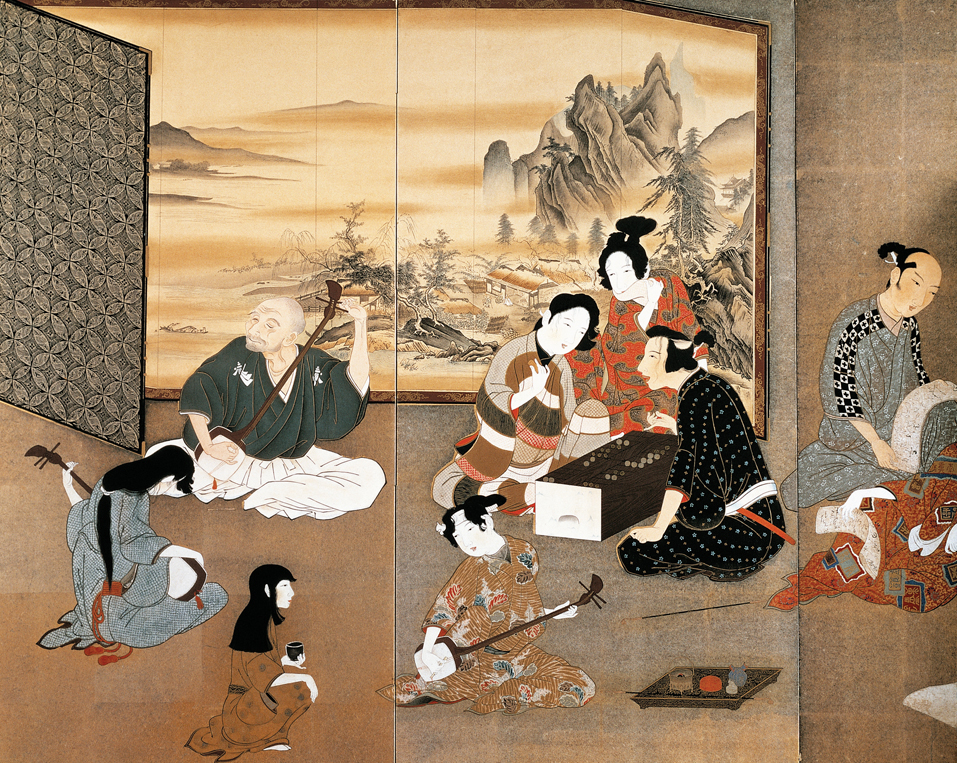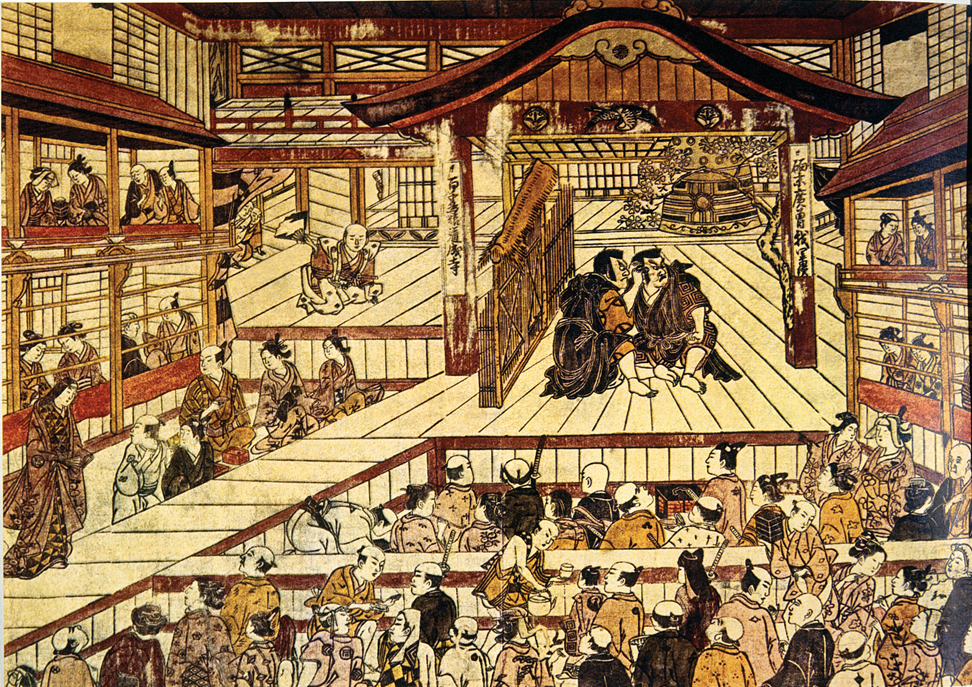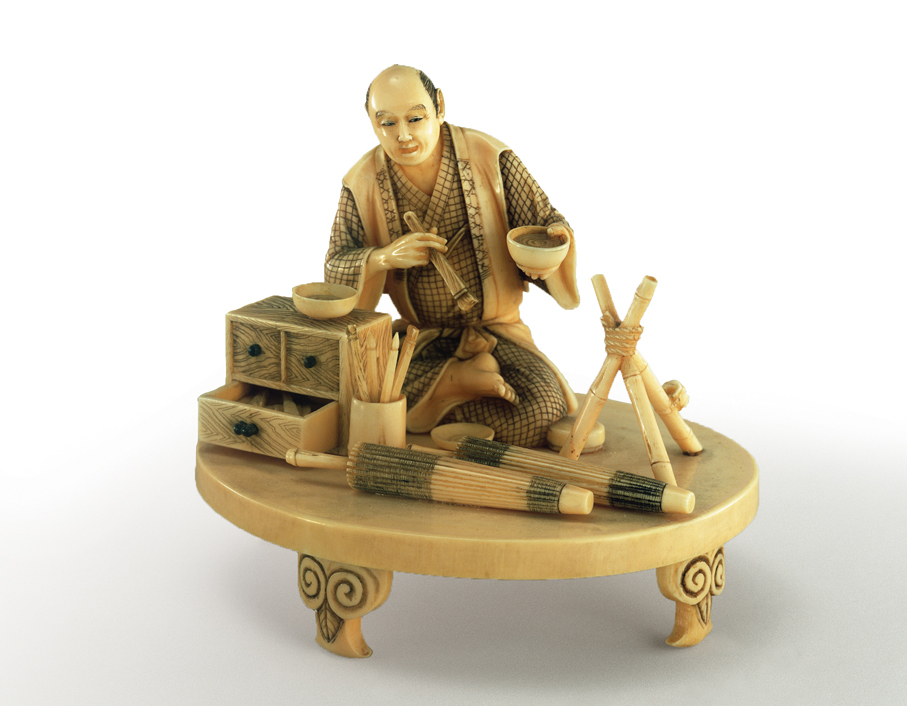A History of World Societies:
Printed Page 634
A History of World Societies Value
Edition: Printed Page 640
The Life of the People in the Edo Period
The Tokugawa shoguns brought an end to civil war by controlling the military. Stripped of power and required to spend alternate years at Edo, many of the daimyo and samurai passed their lives in idle pursuit of pleasure. They spent extravagantly on fine silks, paintings, concubines, boys, the theater, and the redecoration of their castles. These temptations, as well as more sophisticated pleasures and the heavy costs of maintaining alternate residences at Edo, gradually bankrupted the warrior class.
All major cities contained places of amusement for men — teahouses, theaters, restaurants, and houses of prostitution. Desperately poor parents sometimes sold their daughters to entertainment houses (as they did in China and medieval Europe), and the most attractive or talented girls, trained in singing, dancing, and conversational arts, became courtesans, later called geishas (GAY-
Another form of entertainment in the cities was kabuki theater, patronized by both merchants and samurai. An art form created by townspeople, kabuki originated in crude, bawdy skits dealing with love and romance. Performances featured elaborate costumes, song, dance, and poetry. Because actresses were thought to corrupt public morals, the Tokugawa government banned them from the stage in 1629. From that time on, men played all the parts. Male actors in female dress and makeup performed as seductively as possible to entice the burly samurai who thronged the theaters. Homosexuality, long accepted in Japan, was widely practiced among the samurai, who pursued the actors and spent profligately on them. Some moralists and bureaucrats complained from time to time, but the Tokugawa government decided to accept kabuki and prostitution as necessary evils.

Cities were also the center for commercial publishing. As in contemporary China, the reading public eagerly purchased fiction and the scripts for plays. Ihara Saikaku (1642–

Almost as entertaining as attending the theater was watching the long processions of daimyo, their retainers, and their luggage as they passed back and forth to and from Edo twice a year. The shogunate prohibited travel by commoners, but they could get passports to take pilgrimages, visit relatives, or seek the soothing waters of medicinal hot springs. Setting out on foot, groups of villagers would travel to such shrines as Ise, often taking large detours to visit Osaka or Edo to sightsee or attend the theater. Older women with daughters-
According to Japanese tradition, farmers deserved respect. In practice, however, peasants were often treated callously. In 1649 every village in Japan received these regulations:
Peasants are people without sense or forethought. Therefore they must not give rice to their wives and children at harvest time, but must save food for the future. They should eat millet, vegetables, and other coarse food instead of rice. Even the fallen leaves of plants should be saved as food against famine. . . . During the seasons of planting and harvesting, however, when the labor is arduous, the food taken may be a little better. . . .
They must not buy tea or sake to drink nor must their wives. The husband must work in the fields, the wife must work at the loom. Both must do night work. However good-
Peasants must wear only cotton or hemp — no silk. They may not smoke tobacco. It is harmful to health, it takes up time, and costs money. It also creates a risk of fire.2
During the seventeenth and eighteenth centuries daimyo and upper-
This picture of peasant hardship tells only part of the story. Agricultural productivity increased substantially during the Tokugawa period. Peasants who improved their lands and increased their yields continued to pay the same assessed tax and could pocket the surplus as profit. As those without land drifted to the cities, peasants left in the countryside found ways to improve their livelihoods. At Hirano near Osaka, for example, 61.7 percent of all arable land was sown in cotton. The peasants ginned the cotton locally before transporting it to wholesalers in Osaka. In many rural places, as many peasants worked in the manufacture of silk, cotton, or vegetable oil as in the production of rice.
In comparison to farmers, merchants had a much easier life, even if they had no political power. By contemporary standards anywhere in the world, the Japanese mercantile class lived well. In 1705 the shogunate confiscated the property of a merchant in Osaka “for conduct unbecoming a member of the commercial class.” In fact, the confiscation was at the urging of influential daimyo and samurai who owed the merchant gigantic debts. The government seized 50 pairs of gold screens, 360 carpets, several mansions, 48 granaries and warehouses scattered around the country, and hundreds of thousands of gold pieces. Few merchants possessed such fabulous wealth, but many lived very comfortably.

Within a village, some families would be relatively well-
By the fifteenth and sixteenth centuries Japan’s family and marriage systems had evolved in the direction of a patrilocal, patriarchal system more like China’s, and Japanese women had lost the prominent role in high society that they had occupied during the Heian period. It became standard for women to move into their husbands’ homes, where they occupied positions subordinate to both their husbands and their mothers-
A peasant wife shared responsibility for the family’s economic well-
How was divorce initiated, and how frequent was it? Among the elite, the husband alone could initiate divorce; all he had to do was order his wife to leave or send her possessions to her parents’ home. For the wife, divorce carried a stigma, but she could not prevent it or insist on keeping her children. Widows and divorcées of the samurai elite — where female chastity was the core of fidelity — were not expected to remarry. Among the peasant classes, by contrast, divorce seems to have been fairly common — the divorce rate was at least 15 percent in the villages near Osaka in the eighteenth century. A poor woman wanting a divorce could simply leave her husband’s home. It was also possible to secure divorce through a temple. If a married woman entered the temple and performed rites there for three years, her marriage bond was dissolved. Sometimes Buddhist temple priests served as divorce brokers: they went to the village headman and had him force the husband to agree to a divorce. News of the coming of temple officials was usually enough to produce a letter of separation.